
 Skip to content
Skip to content

Lessons To Learn: The Three River House Renovation Hiccups (A PSA On Avoidable Issues)
We made it almost to the end without big hiccups, but here we are and we get to learn (and share) some new things to avoid during your remodel. After talking to all the designer friends in my life I can tell you that no remodeling project goes perfectly. However, the good news is that every single project creates invaluable lessons, especially things to avoid that you can add to your remodeling experience. No grad program can help you avoid all the nuances that come with a remodel. So while learning on the job is painful, it’s just the way it works (easy for me to say as I’m not the homeowner this time – truly the more painful role to have).
The “Too Big” Hole For Wall-Mounted Faucets

This is the first time this has happened to us. I’m not sure if the tile setter or the plumber drilled these holes. So while the holes are standard, the flanges to cover the holes of our faucets are much smaller. This is similar to the “too big J Box” hole issue that I’ve been spouting off about. Yes, a lot of wall mount faucets (and lighting) are “standard” which is what the plumber or tiler will assume, but triple-check the specs of the product before you make the hole, y’all. This is totally fixable but annoying as the tile installer has to pop off the tile, retile, re-grout, and hope that it looks seamless. Then the plumber can come back in and install the fixtures over top of the smaller hole.
A Very Bad Stain On The Natural Stone Island Top
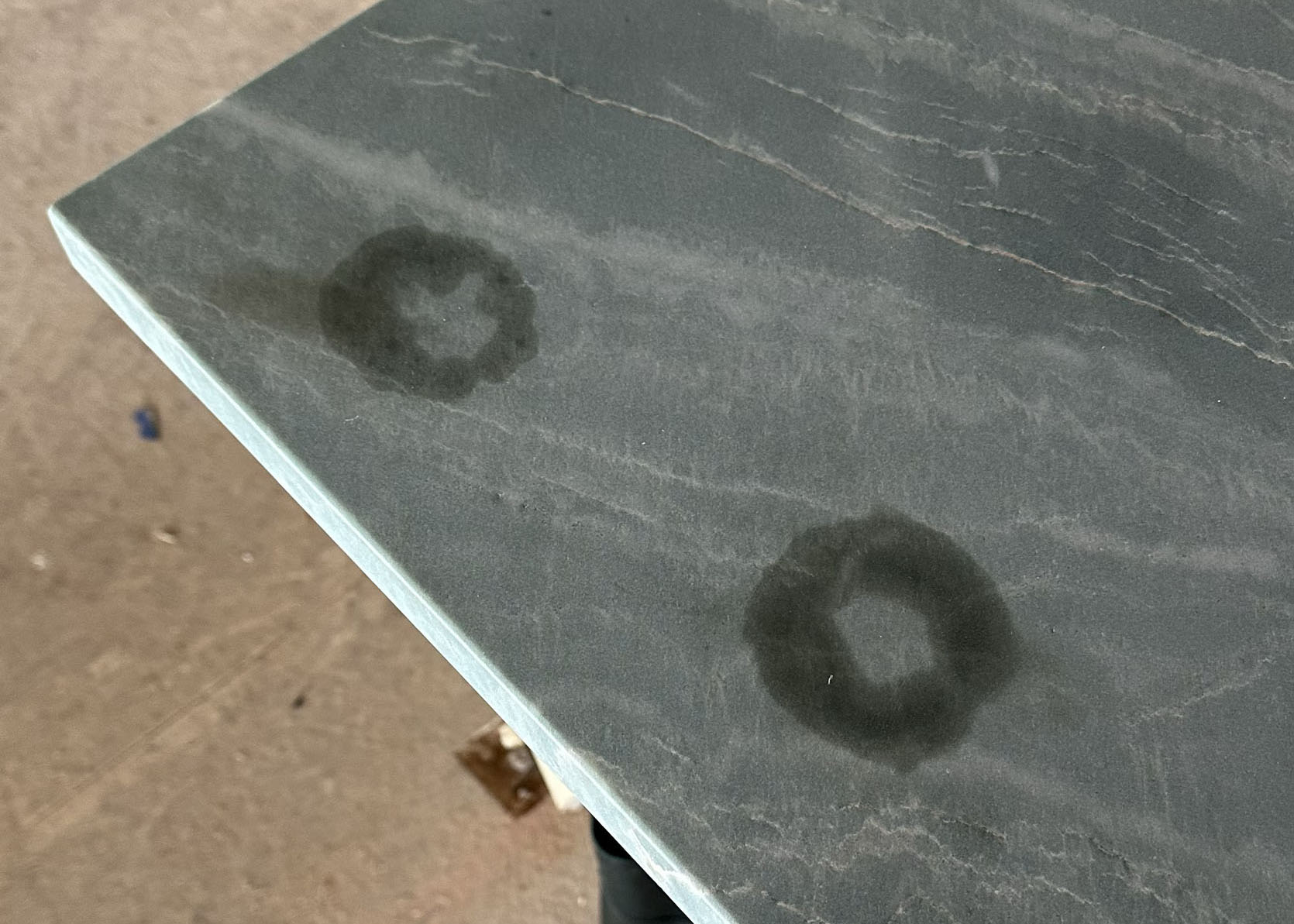
OOF. I convinced my brother to buy beautiful slabs of natural stone for the kitchen instead of using engineered stone. “It will be almost as durable!” she said. We found this incredible green quartzite. Quartzite is historically much less porous than marble (more similar to granite). We were told that leathering it would be the most durable and ensure that you’d never see a stain, etch, etc (no guarantees, but it was their opinion based on experience). GREAT! And then they installed the stone, it looked stunning. Well, that Friday someone put two cups of something on it, and whatever it was bled into the stone over the weekend. And y’all the rings were INTENSE – two huge circles. We assumed they were sealed so then I was panicking that they were in fact sealed and just extremely porous and easy to stain regardless. Ken/Katie were very adamant that they couldn’t live with stone that stained or etched easily. And no one could confirm if the stone was sealed or not. So Ken got a small slab scrap from them that was 1/2 sealed, 1/2 unsealed and he sampled many basic condiments on it to see how the stone would react.
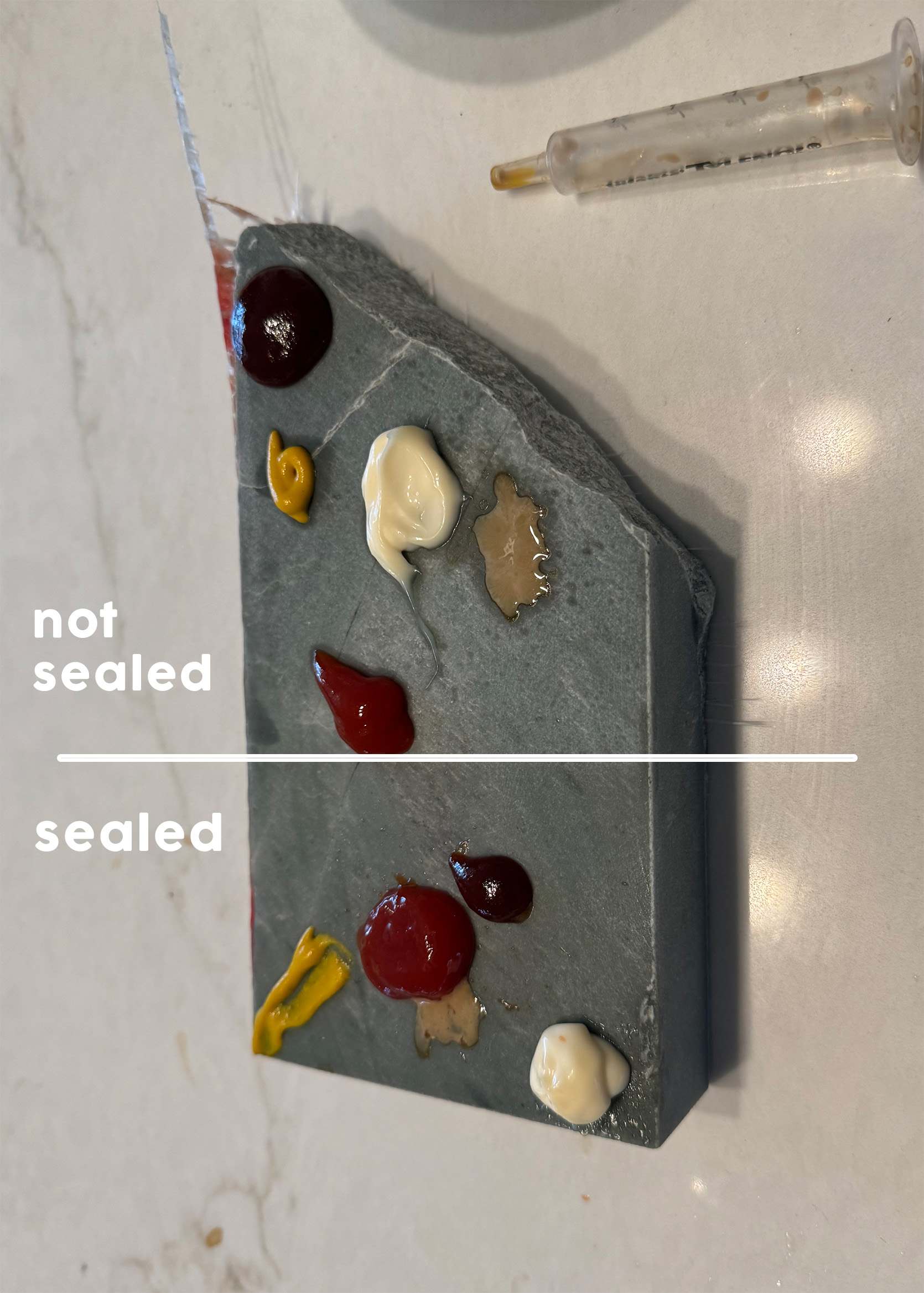
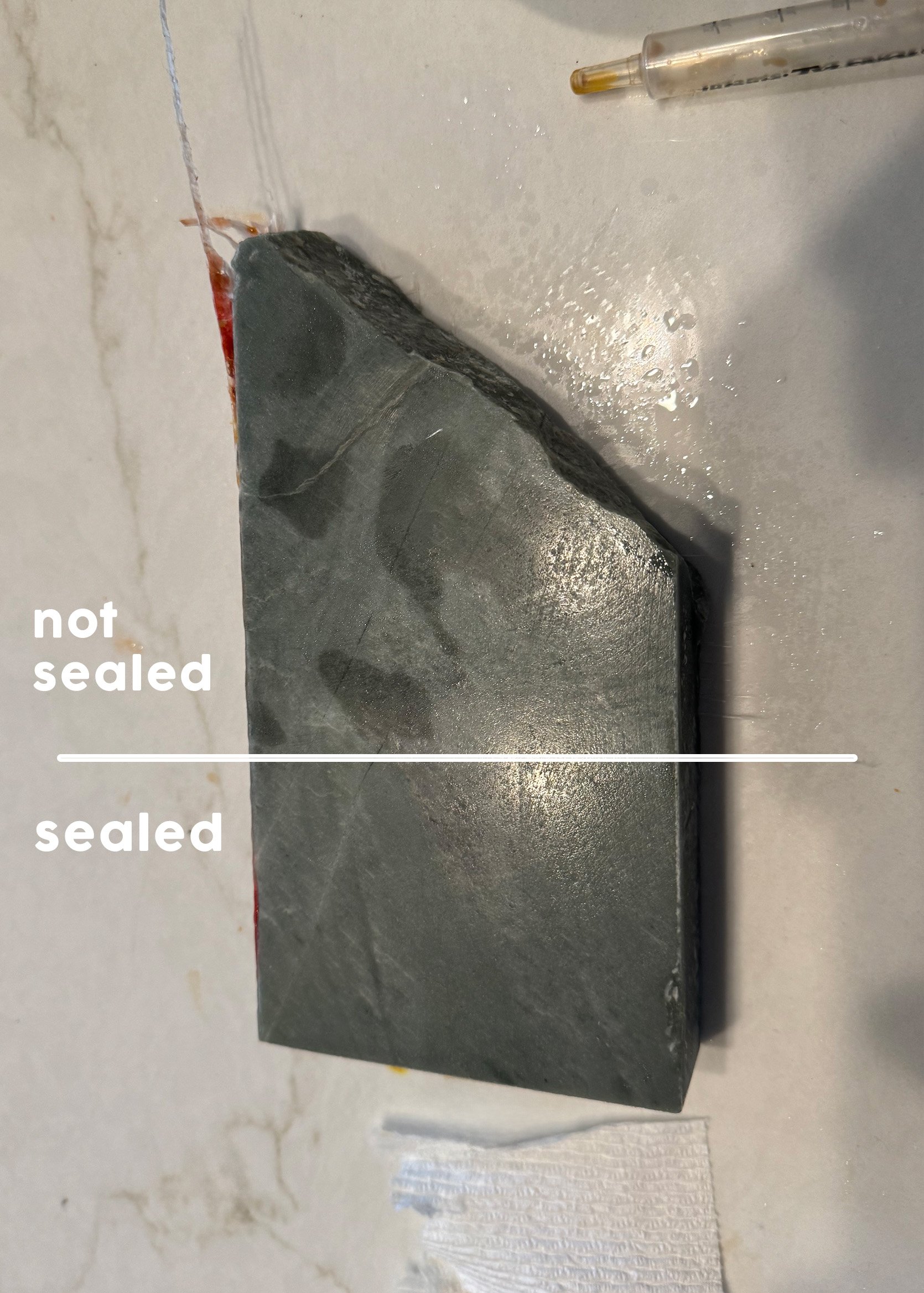
He waited 40 minutes before wiping it off. It all came off on the sealed side (all stained on the non-sealed side). THANK GOD. Worst case scenario was that the stone, which I made them pick, is actually super porous and if so we’d have to essentially rip it all out and replace with one that wasn’t. So once we realized that the sealed part of it really was highly effective at not being porous we were relieved. We had the rest of the countertops (the perimeter) sealed so that no one could accidentally set anything on it.
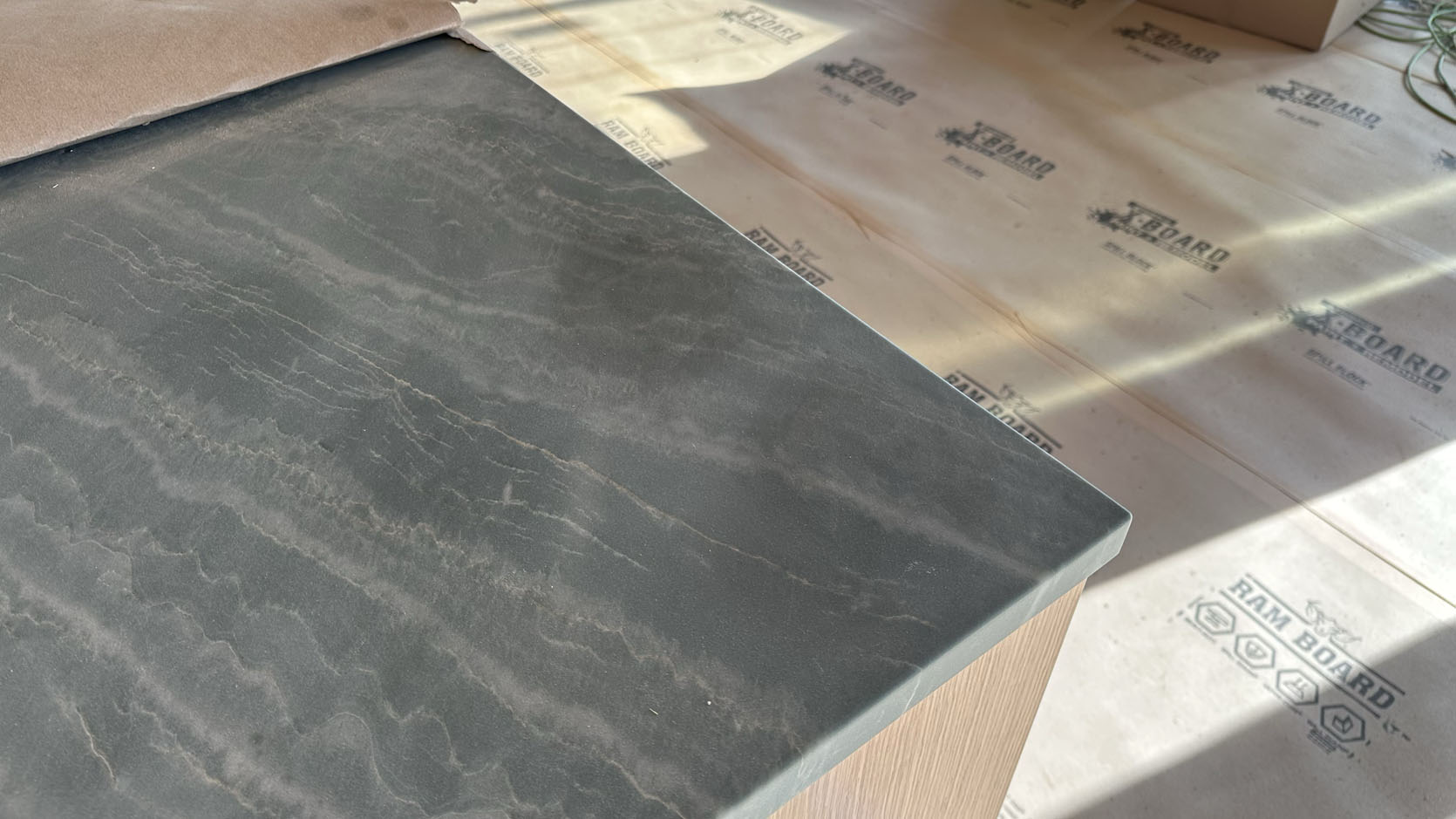
I hate playing the blame game and generally try not to but this could have been a real expensive problem to fix. Our stone fabricators came out and tried to suck out the stain with some sort of vacuum and we are currently in the process of getting it out (thank god). Everyone feels hopeful (they need to come back one more time), but meanwhile, we have a backup slab on hold and are really hoping not to have to fabricate another island countertop. But the point is – make sure that they seal BEFORE leaving the fabricators, seal immediately, or cover. And yes, we think we know who set the drinks on it, but no one is fessing up so we just have to move forward, hope that the stain gets out, and never ever allow another unsealed stone into a house project …
Not Specifying Drawer Cabinet Function
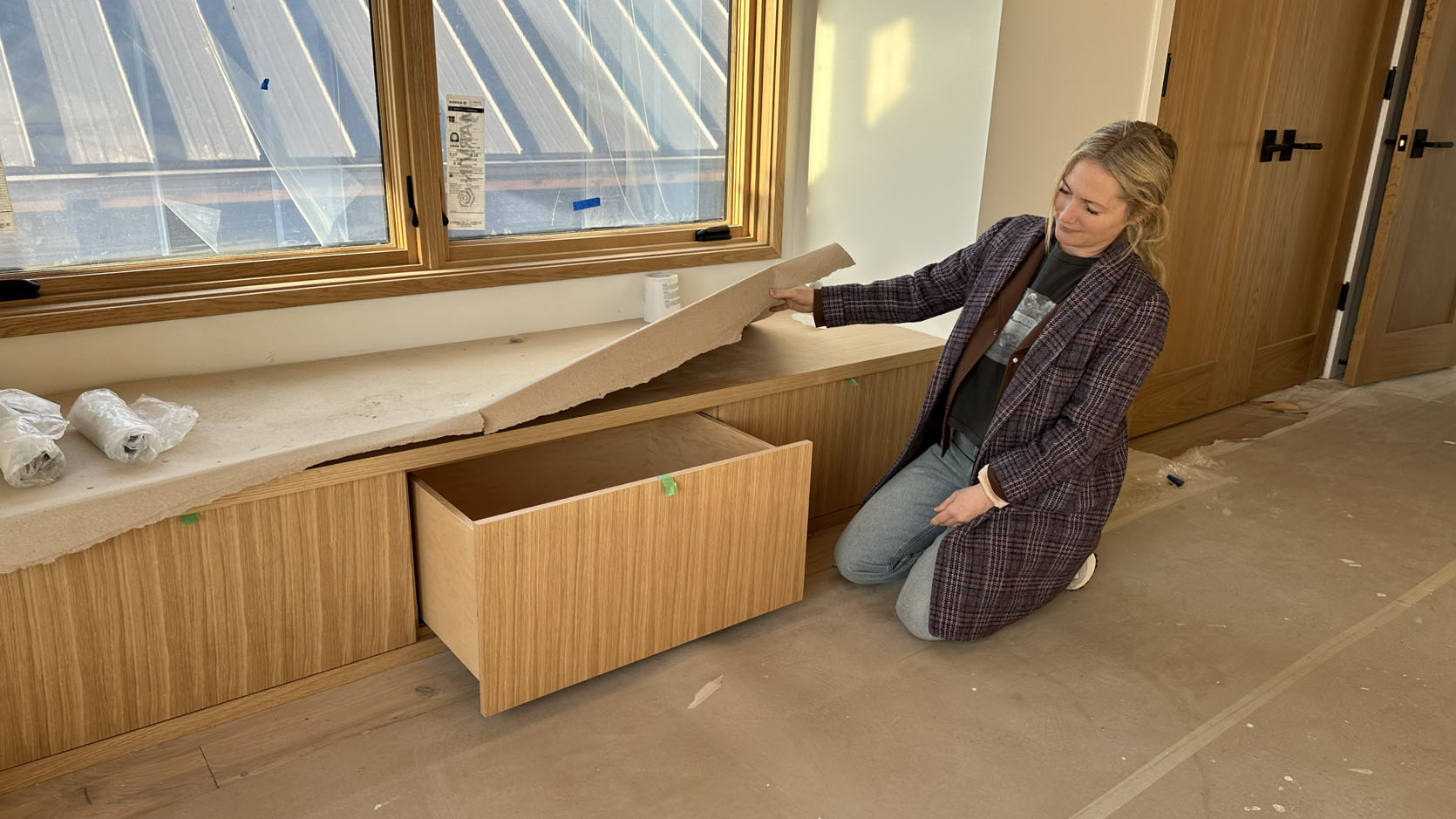
This house has a TON of benches, all with drawer storage (it’s comical how much storage this house has TBH). But we didn’t want hardware on them – we wanted them to look more streamlined and seamless (so they looked more like wooden benches, and less like functional storage. But that didn’t get clearly translated to the cabinet maker, at least not in any writing that I could find (again, not sure whose responsibility it was to do this – Architect? Interior designers? Contractor? Homeowner?). So all the drawers were installed and when we mentioned this to the cabinet guy he said he could come on site and switch them out to be the type of drawers to push and it pops out but it would take him about 30 minutes per drawer and they have about 18 drawers (so essentially 2 days). We aren’t sure what he’s going to charge for it. At one point when we were talking about it, we were given the impression that this was an easy switch because it was super easy to do for cabinets, but drawers are more of a thing and they would need to know the no-hardware mechanism ideally before leaving the shop.
The funny thing is that sometimes even putting everything in writing doesn’t work. I think it’s the nature of house building. I have found that so many contractors and subs are working so fast to get stuff done on a million projects that even if it’s clearly written somewhere, digitally, they might miss it. It’s not always a lack of communication, but there is so much happening that it’s hard to keep things straight and none of these guys work on computers a lot and finding old text threads is hard. The best you can do (which we have this whole time) is a walk-through with the subs, then a labeling of things on site, taping up drawings with notes, etc.
Happy remodeling and hope these will save some of you some future headaches:) xx
Opening Image Credits: Photo by Kaitlin Green




‘I hate playing the blame game and generally try not to…’
This says everything about you, lovely person.
You are absolutely right that putting everything in writing doesn’t work. The contractor and subs never seem to write anything down, ugh!
This is absolutely true and very frustrating. BUT if you have been clear in writing, and especially if they have confirmed back via email, it at least satisfies the issue of who pays to fix the mistake.
You’ve probably already found a solution for the drawers, but I’m a designer for a construction company (and a cabinet rep), and use this company for touch latches: And I can SO relate to little things like this getting missed by our project manager and subs. Along with trying to label everything on the drawings, I have a shared Dropbox account with our project manager, and keep a spreadsheet with fixture selections for each room that he can pull up on his phone on site. A recent, simple change I’ve made is only putting 1 or 2 cabinet elevations per page on 11×17 paper so they’re big and the labels are big. I make 2-3 copies and our project manager keeps them in one spot on site for subs to refer to. Like you said, some of these subs might go to 2 or 3 houses in one day and are in a hurry, so I’ve found making the plans as easy to read as possible results in less mistakes.
If the vacuum process that the stone people are doing doesn’t work, give this a try: I have marble counters and backsplash and despite my best efforts, grease stains on the backsplash behind the stovetop are inevitable. This stuff works like a champ, even if the stains have been there for months and months. Leave it on for the full 72 hours and don’t freak when you take it off and there’s still a spot where the cleaner was, it’ll go away in a few hours. Worth a shot before you replace!
“Quartzite will not etch from acids like lemon juice or vinegar. If a rock labeled as quartzite becomes etched from acid, then it’s been mislabeled. Marble and dolomitic marble, on the other hand, will etch from these acids. Dolomitic marble etches slightly more slowly than regular marble. But quartzite will not etch at all from normal kitchen acids. Not one little bit!”
……..” (again, not sure whose responsibility it was to do this – Architect? Interior designers? Contractor? Homeowner?).”
As advice to us, it would help if you could tell us who would be responsible for this so that we can note it in our own renovations. Thank you for pointing this out.
Not an expert, but someone who has done several renovations and navigated the blame game a lot, here’s my two cents…in this instance you would need to go back and see what your paperwork said on the stone order. If the counters were SUPPOSED to arrive already sealed, then it’s a mistake from the stone fabricator. If they weren’t, it’s the kind of thing that a designer or contractor (whoever actually purchased the slabs and liaised with the fabricators) MIGHT catch, meaning might have either called out that they can’t arrive unsealed or known to cover and protect until they are sealed, but neither are stone experts. If the stone fabricator doesn’t routinely seal (and remember, the company that fabricates is not necessarily the company that sold you the slabs) I would say that they are not a provider I would work with again as that’s the kind of thing I would have hoped would have been brought to the purchaser’s attention as they ARE the stone experts. So it would come down the the question of is there a paper trail that the counters should have been delivered sealed or sealed on site immediately after install and if not,… Read more »
Thank you!
If I’m working with (and paying!) architects and interior designers, as a homeowner, I expect those people to be across details like the drawer closing and hardware. Making decisions and paying for everything is stressful enough without having to double check that professionals are doing their job. I say this as someone who has just finished a renovation and yes, had some hiccups along the way that should have been picked up by the designers.
What a difference the sealer makes! Do you happen to know what brand of sealer they used?
I’m a project manager for an interior design studio and my whole job is basically to make sure stuff like this doesn’t happen… but it still does! Honestly with so many moving parts it’s basically unavoidable. But every time I do a project (or read your blog posts about renos!) I learn more about how to avoid them. Thanks for sharing 🙂
Oh my, those rings on the quartzite made me gasp! I am so glad there is hope for getting them out.
If this is scaring anyone away from quartzite, our sealed leathered quartzite is looking great even with our kids routinely making messes with fresh lemons, baking, etc. No rings or etches.
Lol, I gasped too. And also WHAT was that person drinking or eating??? Like for real what could they have been consuming that was that greasy/grimy on the OUTSIDE of their vessel? I’m so confused and I need answers and am not as gracious as Emily is, apparently, ha
I wonder if they were candles and the heat made the dark rings or a drink that they dipped in mayo?
I thought the same thing! Holy moley, what were they drinking and what else is covered in that mess?! Emily, take a good look around the house, stat!
Came here to say the same thing! We have sealed leathered quartzite and it’s AMAZING and I’m so glad we went with it. We’ve had a couple of stains (our fault) and they’ve all come out with time or a little baking soda paste.
I have sealed polished quartzite, and OCD tendencies which made me shy away from marble — +1 to the durability with good sealant. My fabricator said that the sealant lasts for 25 years too, no need to re-apply like with marble.
As an alternative fix for the drawers, what about using some super low profile lip pulls in a color similar to the wood tone?
Wow! That’s crazy about the stone, but thank goodness it wasn’t sealed yet. Wishing you luck in totally get the stain out.
I’m going to share this post with my husband, who adamantly believes that the “in writing” scenario means everyone has all the info they need to do everything correctly at all times. I’ve told him a million times that you cannot rely on people’s memories or assume that they are checking paperwork or whatever, you have to be hands-on and ask questions. This is why we have yet to do our remodel (because I don’t want to be the one solely responsible for walking through everything every single day since he thinks it’s unnecessary), so maybe this will help convince him that it’s a team effort on all sides.
OMG, Emily, I’m weeping for you. Short disaster story here: I had to take a thick sharpie and draw my kitchen on the walls in order to have the contractor put things in the right place. If I could have, I would have guided his every move with my own hands. For instance, and this is just one instance out of so many, he put an open shelf 3″ from the ceiling to hold my BIG pots. Still, I’m weeping for you. (And can’t wait to see how it all turns out, gorgeous, of course).
I drew on the walls and one of my outlets is still in the wrong place…. so frustrating.